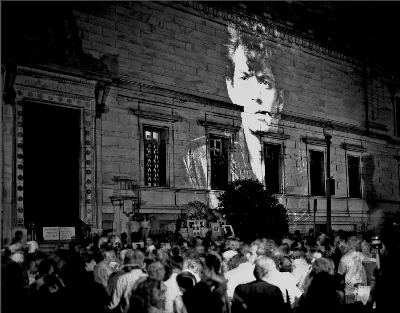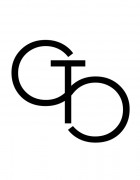In July 1989, several months after the death of Robert Mapplethorpe, his retrospective exhibition The Perfect Moment was due to open at the Corcoran Gallery of Art in Washington DC. However, public controversy surrounding National Endowment of the Arts funding art led to its cancellation. On the night of the would-be opening, a group of activists, curators and artists assembled in front of the gallery. Artist Frank Herrera captured the ephemeral projections of slides on the building’s walls honouring the works that should have been shown within.
Activism is historically inherent to queer art and visual culture, both in terms of artistic and curatorial practices. From Stonewall to the HIV/AIDS crisis of the 80s whose tensions and grief boil to the surface in Herrera’s photographs, the fight to preserve and honour past queer artists has worked hand-in-hand with the need to challenge and subvert society’s status quo around gender, sexuality and orientation. This curatorial activism was defined by feminist curator Maura Reilly as a protest against an established art canon in favour of straight, white, Eurocentric male artists. In her 2011 essay “Towards A Curatorial Activism”, she pinpoints the “ethical responsibility” of curators to ensure that a gallery’s walls reflect the society we are part of, dismantling a so-called universal “default”.

Photograph of The Perfect Moment protest, June 30, 1989, Frank Herrera Corcoran Gallery of Art, Washington, D.C. © Frank Herrera
Visibility and commemoration are the founding principle behind the Leslie-Lohman Museum of Gay and Lesbian Art in New York: emerging from an initial will to preserve and document art which would have been thrown out by the families of gay artists dying from AIDS, it has grown into a complex and multi-layered testimony of queer artists’ achievements. This provides a unique collection, placing queerness at the centre of its curatorial framework in a political act of remembrance which looks towards future practices. However, if there is such a thing as a queer curatorial practice, it soon becomes apparent that “queer art” as an exhibition model runs the risk of being both reductive and segregating in relation to a traditional museum’s “default” collections and programs. The exhibition In a Different Light curated at UC Berkeley Art Museum and Pacific Film Archive by contemporary artist Nayland Blake and Director of Berkeley Art Museum Lawrence Rinder in 1994, navigates these issues between activist inclusion and tokenism. It focuses on “queering” a narrative mingling LGBTQ artists with those whose work reflects concerns of identity, gender performance and representation inherent to postmodernist concerns. For Blake, in his 1996 paper reconsidering the exhibition, “the idea that identity and culture are non-organic constructs is also one of the most important characteristics of postmodernism (…) the discourse of the postmodern is the queer experience rewritten to describe the experience of the whole world.” His analysis of the “viral reinsertion” of queer politics into general discourse assimilates them into the societal concerns relevant to a contemporary audience. The metaphor of the “virus” post-1980S powerfully reclaims a narrative wrecked by tragedy and erasure. In a Windy City Times interview from November 2016, discussing the exhibition Art AIDS America touring the US in 2015-6 that he co-curated with Tacoma Art Museum director Rock Hushka, the activist curator, and president of the Leslie-Lohman Museum, Jonathan David Katz commented on Felix Gonzalez-Torres’ words on producing queer art as a virus, rather than the opposition:
“He made works of art that were the fundamental equivalent of HIV; that passed underneath the notice of the art world’s immune system at the museum and replicated within its environment.“
Queer curating is seen as a way of reclaiming present and future queer legacies by understanding queerness not as a supporting role, but a defining and central practice within modern and contemporary art.
Queer curatorial activism can therefore be seen as an attempt to change the system from within, through group exhibitions which fit into the institutional framework and respect the procedures of collecting and commissioning new works. This assimilating vision confronts itself to a strand of queer curatorial activism considering that queer art and curating should remain intentionally on the margins to actively challenge and question the status quo rather than integrate it gratefully, in order to raise the profile of current issues and concerns relevant to its communities.
The Feminist Art Gallery (FAG) in Toronto, directed by artist duo and couple Allyson Mitchell and Deirdre Logue was founded in 2011 as an extension of their own studio, an exhibition space in their back garage and a space for queer and feminist artists and activists to produce works, talks and performances. The FAG relation to museum curating is apparent through the artists’ series CAN’T/WON’T: “can’t compete/won’t compete/can’t keep up/won’t keep down.” Their presence at a Tate conference on queer and feminist curating a year after their foundation may have therefore seemed odd, but they establish their practice as a critical response to the art world system, rather than antagonism. By focusing energies on a loose, “untamed” and unpredictable form of curating informed by their roots in activist and DIY culture, Mitchell and Logue provide an alternative to assimilating artists into a system which still revolved around a straight, white and male standard. Founded in 2012 and London-based, co-founded by Giulia Casalini and Diana Georgiou, CUNTemporary acts as a collaborative platform to explore queer and feminist practices, inclusive of all subcultures excluded from mainstream social and political discourse. As an institution without walls it has the creative freedom to engage with a range of practitioners from writers to performers through to visual art without the concerns of a traditional gallery space. This initiative is possible through the creation of a strong online communications platform and an immaterial network of curators and writers, both UK-based and abroad. Their latest event, Power, Subculture & Queer Stages was a symposium around queer visibility, invisibility and performance in public spaces, with contributions from scholars, stylists, drag performers and artists. These spaces and collectives emerge as essential platforms to foster the energy and experimentation of queer and feminist practices that are in touch with the audiences and communities whose stories they set out to make visible.

CAN’T/WON’T (2012), Allyson Mitchell, Photos: KIRBY
Similarly, institutional programming and permanent collections must reflect this complexity of ideas and experiences, achieving inclusion within a contemporary art system without compromising its identity, power and message. Artist duo Rosie Hastings and Hannah Quinlan’s installation UK Gay Bar Directory provides a strong example of these creative interconnections. The Somerset House commission was coordinated by Arcadia Missa, a Peckham-based gallery fostering discourse around digital practices, gender issues and institutional critique, founded by Rozsa Farkas. The installation was an archival moving-image compendium of 180 gay bars across the UK, exploring both the sense of community and belonging they fostered and the exclusion they could exert on anyone outside of a white gay identity. Its historicising tone served as both a critique of the community and a comment on the importance of queer spaces for the community to live and thrive. Open from July to the end of August 2016, the installation’s presence in the aftermath of the Orlando nightclub shooting provided a raw, painful reminder of the importance of these spaces in a climate of violence, disappearance and denial of civil rights for queer communities. On a vaster, institutional, scale Tate Britain’s recent Queer British Art exhibition is a powerful survey redefining British social and art history through a queer lens starting with the gender ambiguity of the Pre-Raphaelites and ending with Francis Bacon and David Hockney. While 1967 as the cut-off year may have evaded more postcolonial and politicized accounts of queer British culture, its public programming shows a motivation to work with queer contemporary artists on activist subjects. This includes the Open Studio: Black Flamingo events in which artist and writer Dean Atta addresses issues of queer black visibility central to his work through artwork-making and zine production, interacting with audience participation and contributions by important London-based queer artists and writers. This inclusion extends to long-term curatorial and commissioning roles. For instance the appointment of Ajamu X to a 2016 curatorial residency at Visual AIDS will allow for in-depth research and curatorial involvement in the research library’s archives in order to combine the institution’s aims to use art as a weapon against AIDS with his own in uncovering queer black experiences in the UK which led to the foundation of rukus! as a project to question and disrupt usual narratives around queerness.
Queer curatorial activism cannot be reduced to a single agenda when its aims are purposefully to ensure that visibility over queer discourse, art and political issues will allow for a multiplicity of narratives to emerge in museums, alternative spaces and initiatives alike. Rather than feeling condemned either to complete marginalization on the borderlines of the art world or to assimilation within the codes of the museum, queer curatorial activism emerges as a practice which navigates in-between different spaces, approaches and audiences. Its refusal to be so easily pinned down and codified exudes queerness in its very form and indicates its ability to shift and evolve to reflect social and political concerns.
Claire Mead
Claire Mead is an art historian and independent curator based in Paris. She has obtained her BA in Art History from Oxford University in 2013 and an MA in Curating the Art Museum from the Courtauld Institute in 2016. Her recent academic and independent research has focused on experimental film within the art museum, and has extended to consider feminist and queer film and visual arts practices and the way they are curated in the museum, exploring issues surrounding diversity and tokenism in the field. She has recently delivered the seminar “queering the museum” at Middlesbrough Museum of Modern Art in April 2017 and has participated in the “Edge of Frame” symposium on experimental animation at the Whitechapel Gallery in December 2016 to look at issues surrounding animation and museum interpretation. Claire has co-curated the MA Curating exhibition “Confusion of Tongues: Art and the Limits of Language” at the Courtauld Gallery in 2016, as well as the East Wing Biennial “Artificial Realities” at the Courtauld. She is now working as an independent curator and consultant for emerging artists in Paris, while continuing to write as an art critic on her blog, “Art is a Conversation”.
Featured image: UK Gay Bar Directory (2016), Rosie Hastings & Hannah Quinlan Anderson. Image Courtesy of The Artists


Pingback: Curating Queerness as an Activist Practice – Curating the Contemporary – queeratorial